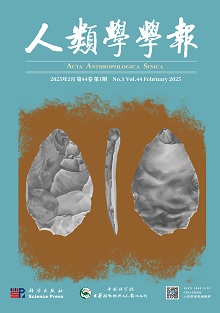A study of the physical characteristics of the Yunnan Mongol people
ZHENG Lian-bin; LU Shun-hua; DING Bo; YU Hui-xin; LIU Hai-ping; ZHANG Xing-hua
2011, 30(01):
74-85.
 Asbtract
(
606 )
Asbtract
(
606 )
 PDF (381KB)
(
231
)
Related Articles |
Metrics
PDF (381KB)
(
231
)
Related Articles |
Metrics
Sixty-seven physical characteristics (9 somatoscopic features and 58 anthropometric features) of 439 Mongol adults (202 males and 237 females) from Tonghai County, Yunnan Province were investigated. In addition to these features, 32 physical indices, stature distributions and 11 related indices were also calculated. The results of this research were as follows: the percentages of the Mongoloid fold and eyefold of the upper eyelid were low; the percentage of medium-sized nasal root height was the highest in males; the small-sized nasal root height was the highest in females. Most of the Yunnan Mongol adult sample were medium-sized in the alae nasi and in the upper lip height. The lobe type was mostly triangular in shape. The colors of hair, eye and skin were black, brown and yellow, respectively. Typical physical characteristics of the Yunnan Mongols were sub-middle stature, mesocephaly (length-breadth index of head shape), hypsicephalic type, hyperleptoprosopy, medium chest circumference, medium shoulder breadth, mesatiskelic type, narrow distance between the iliac crests and a medium length of the trunk. The highest percentage of male stature was sub-middle type, whereas females were small-sized. Males were mostly metriocephalic type (breadth-height index of head shape), while females were tapeinocephalic type. Maximum head length, nasal height, nasal breadth, mouth breadth and morphological facial height of the Yunnan Mongols were the largest among seven Mongol ethnic groups. Maximum head breadth, minimum frontal breadth, bizygomatic breadth, stature and body weight were the smallest feature. In 14 of the Yunnan ethnic groups, morphological facial height, nasal height and body weight of the Mongols were the largest feature. The stature was larger, while nasal breadth and mouth breadth were smaller. In conclusion, the physical characteristics of the Yunnan Mongols were close to that of the Achang, Bai and Yi, which belong to the South Asian type of Mongoloid. The physical characteristics of the Yunnan Mongols were quite close to the North Asian type rather than to other South Asian types, which may be a result of gene exchange between surrounding ethnic groups.









